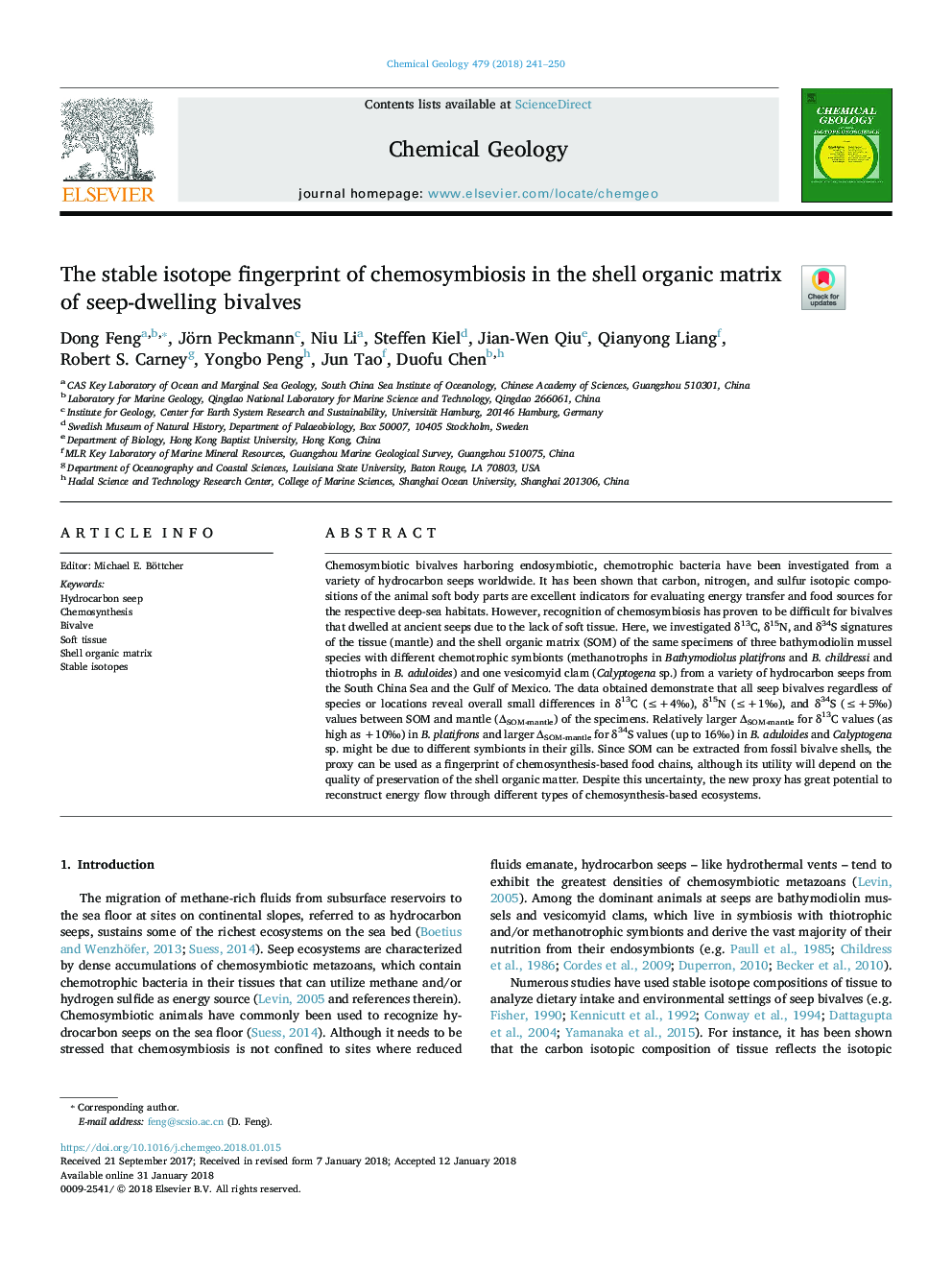| کد مقاله | کد نشریه | سال انتشار | مقاله انگلیسی | نسخه تمام متن |
|---|---|---|---|---|
| 8910393 | 1637495 | 2018 | 10 صفحه PDF | دانلود رایگان |
عنوان انگلیسی مقاله ISI
The stable isotope fingerprint of chemosymbiosis in the shell organic matrix of seep-dwelling bivalves
ترجمه فارسی عنوان
اثر انگشت ایزوتوپ پایدار شیمیایی بیوسیز در ماتریس آلی پوسته دوغاله نشسته
دانلود مقاله + سفارش ترجمه
دانلود مقاله ISI انگلیسی
رایگان برای ایرانیان
کلمات کلیدی
سدیم هیدروکربن، شیمی درمانی، دوشیزه بافت نرم، ماتریس آلی شل، ایزوتوپهای پایدار،
موضوعات مرتبط
مهندسی و علوم پایه
علوم زمین و سیارات
ژئوشیمی و پترولوژی
چکیده انگلیسی
Chemosymbiotic bivalves harboring endosymbiotic, chemotrophic bacteria have been investigated from a variety of hydrocarbon seeps worldwide. It has been shown that carbon, nitrogen, and sulfur isotopic compositions of the animal soft body parts are excellent indicators for evaluating energy transfer and food sources for the respective deep-sea habitats. However, recognition of chemosymbiosis has proven to be difficult for bivalves that dwelled at ancient seeps due to the lack of soft tissue. Here, we investigated δ13C, δ15N, and δ34S signatures of the tissue (mantle) and the shell organic matrix (SOM) of the same specimens of three bathymodiolin mussel species with different chemotrophic symbionts (methanotrophs in Bathymodiolus platifrons and B. childressi and thiotrophs in B. aduloides) and one vesicomyid clam (Calyptogena sp.) from a variety of hydrocarbon seeps from the South China Sea and the Gulf of Mexico. The data obtained demonstrate that all seep bivalves regardless of species or locations reveal overall small differences in δ13C (â¤+4â°), δ15N (â¤+1â°), and δ34S (â¤+5â°) values between SOM and mantle (âSOM-mantle) of the specimens. Relatively larger âSOM-mantle for δ13C values (as high as +10â°) in B. platifrons and larger âSOM-mantle for δ34S values (up to 16â°) in B. aduloides and Calyptogena sp. might be due to different symbionts in their gills. Since SOM can be extracted from fossil bivalve shells, the proxy can be used as a fingerprint of chemosynthesis-based food chains, although its utility will depend on the quality of preservation of the shell organic matter. Despite this uncertainty, the new proxy has great potential to reconstruct energy flow through different types of chemosynthesis-based ecosystems.
ناشر
Database: Elsevier - ScienceDirect (ساینس دایرکت)
Journal: Chemical Geology - Volume 479, 20 February 2018, Pages 241-250
Journal: Chemical Geology - Volume 479, 20 February 2018, Pages 241-250
نویسندگان
Dong Feng, Jörn Peckmann, Niu Li, Steffen Kiel, Jian-Wen Qiu, Qianyong Liang, Robert S. Carney, Yongbo Peng, Jun Tao, Duofu Chen,
